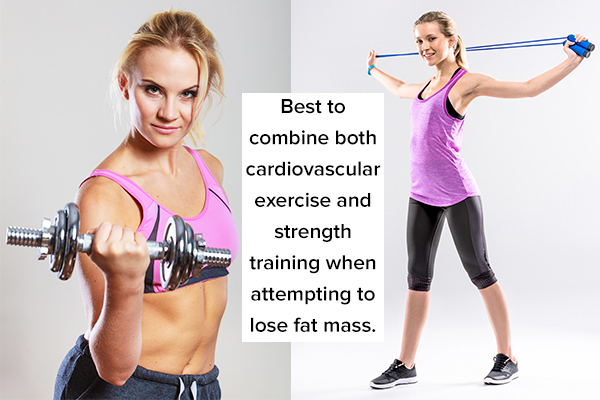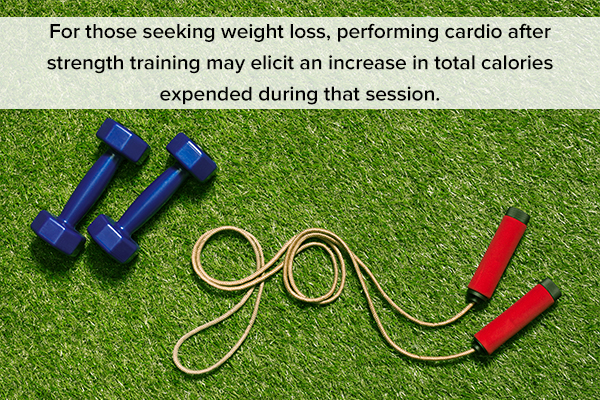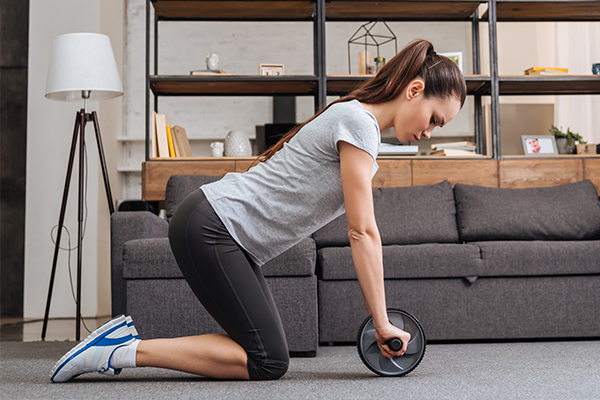In this article:
When and how one chooses to weight train and perform cardio exercises are dependent on one’s goals and current health and fitness level, along with one’s schedule and equipment access.

For most individuals attempting to lose weight, time is very limited. This may be the reason they have not exercised effectively in the past. In this case, beginning a training regimen that combines both cardiovascular activity and resistance training may be ideal to improve overall fitness when time is restricted. (1) These workouts can be done two to three times per week.
Which Burns More Calories: Cardio or Strength Training?
In general, cardiovascular exercise burns more calories than weight training. This is because the time spent exerting effort during a weight lifting set is limited (albeit intense).
A set of dumbbell bench presses, for example, may only last 5–10 seconds. Meanwhile, common cardiovascular exercises, such as running on a treadmill, can be done for an hour or more.
Which Out of Cardio and Strength Training Is Better for Fat Loss?

It is best to combine both cardiovascular exercise and strength training when attempting to lose fat mass. This is because cardiovascular exercise can burn a great deal of calories, but strength training ensures a gain or maintenance of lean body mass.
Bone mineral density (BMD) (2) is also maintained in those who strength train, resulting in higher body strength and resiliency. Preserving BMD may lead to decreased osteopenia (natural loss of muscle that occurs with age).
Combining Strength Training and Cardio to Tone Your Muscles
Weight training does not directly burn belly fat. However, muscle gained in the midsection can recomposition the surrounding area. This introduces greater amounts of muscle to an area previously consisting of mostly fat. These now-larger muscles will show more easily through the skin when there is fat loss.
However, weight/fat loss can only be achieved by consistently creating a caloric deficit (greater amount of calories are burned than consumed). This combination of muscle gain (from weight training) and fat loss (from the caloric deficit) creates what one might call a “toned” look.
The Best Way to Pair Cardio and Strength Training

Cardiovascular exercise should not be seen as a detriment to strength training progress (when completed at the correct times, in the correct amounts).
For example, a significant amount of running or rowing can decrease energy levels preceding a strength training routine. It is ideal for most to begin cardiovascular exercise after a weight training session.
For those seeking weight loss, performing cardio after strength training may elicit an increase in total calories expended during that session. (3) But this advice varies greatly.
Some individuals prioritize technical skill practice (such as sport-specific agility drills), which are best done before weight training. Or they may value sprint performance heavily, which then should be trained first.
The Best Strength Training Routines
Strength training is important for all as it can decrease athletic and occupational injury risk along with increasing performance. (4) Even simple activities of daily living (grocery shopping, childcare, locomotion) can be improved by having a stronger, more robust body.
The best strength training routines consist of several compound (multijoint) exercises completed at 60%–85% of one-repetition maximum (or 1RM), 4 sets per body part, per week. (5)
For those who do not know their 1RM, utilize the rate of perceived exertion (RPE). RPE grades the amount of effort needed to complete a given set and ranges from 1 to 10. Here, 1 = very easy and 10 = barely completable. Attempt to lift an amount of weight for a number of repetitions that score 6–8.5 on this scale for your sets.
Rest periods will generally be recommended based on goal. In general, rest longer (2–5 minutes) to maximize muscle strength development, or rest for shorter durations (≤30 seconds) to maximize muscle endurance.
Weight training sessions can be done relatively quickly, 15–20 minutes. Training programs that include supersets may be best if time is a limiting factor. But be advised, supersets are not ideal for those attempting to maximize power or those with preexisting cardiopulmonary conditions.
Is Strength Training Recommended for Women?

Yes, females should strength train. There is a general misconception that females will gain muscles and look more masculine after strength training.
A female who is simply weight training and progressing in strength on her exercises will not look like a competitive bodybuilder or some fitness celebrities who usually take androgenic substances that elicit masculine features, such as high degrees of muscle hypertrophy, deep voices, wide shoulders, squared facial features.
Thus, most women don’t have to worry about developing these features unless substances are used. I have found, however, that emphasizing lateral deltoid development, such as using overhead press variations and side lateral dumbbell exercises, can masculinize the shoulders of some women.
Those exercises can be avoided if one is concerned about developing masculine shoulders. But muscles such as the shoulders (deltoids) and trapezius should be trained even still.
Power, strength, endurance, and other positive qualities can be obtained in those areas by doing isometric shoulder exercises such as Turkish get-ups.
The Best Kind of Cardiovascular Exercises
I have found that the best cardiovascular exercises depend on equipment and space closest to home.
For example, if there is a treadmill in one’s basement, that may be the best option for them. If one lives near a park or beach, walking laps along those locations is a great option.
I say that the best cardio exercise depends on what is closest to the individual because what is closest to one is what takes the least effort to travel and utilize.
I am a strong advocate for low-intensity steady-state cardio, abbreviated LISS. This is because people of all ages and, oftentimes, all medical conditions can perform LISS. The ideal practice of LISS is to walk/cycle/row, etc., at a pace that is challenging (elevated heartbeat and breathing rates) for a sustained period.
Fatigue will not be severe, and many calories can be burned. Most sources agree that 30 minutes of moderate cardiovascular exercise, as described above, completed 5 times per week will yield greater health. (6)
The duration of cardiovascular sessions will depend on several factors. For example, low-intensity walking can be done for a very long time, burning a significant number of calories without producing significant body stress.
But high-intensity interval training (HIIT) (7) may only be able to be done for a total workout time of 4 minutes, once per week. This is due to HIIT’s considerable strain on the body.
Some Important Guidelines for Physical Training

I believe there are three important points to consider when embarking on any training method:
1. Progress at your own pace
Each individual will begin programs in different health states, abilities, and resources. This will dictate how fast results manifest.
2. Progressively overload
It is ideal to increase the amount of weight you are lifting or the number of repetitions you are lifting per set, at least once a week. The same principle applies for timed exercise, but inversely. If you are working on improving your 1-mile time, you would like to see that number decreased slightly each week.
3. Do not be a slave to social media algorithms or the health/beauty industry
If you are training in a way that is improving your health and happiness, feel free to continue that training style. Do not feel pressured to try the advertised greatest and latest exercise or diet. Chances are what is marketed as the latest and greatest health aid is not.
Final Word
One can embark on an exclusive weight training regimen and lose weight successfully as long as a caloric deficit is present. Both cardio and strength training have their own merits but a wholesome workout that aims to burn calories and gain muscle mass for a slim, toned body involves a combination of both these forms of exercises.
Strength training should generally be done first, except in cases where one is an athlete and sprint training, distance running, or other sports-specific training is being prioritized that day. You can seek the help of a professional trainer or gym instructor to come up with a customized exercise routine that meets your fitness goals.
The most important rule is consistency without getting overexerting yourself. Some people may have greater stamina than others or show results sooner, but you must listen to your own body and stick to your own workout.
You should start easy to first relax your stiff body and then gradually proceed to more demanding exercises. Also, make sure to give your body enough resting time to recover from the physical train of the previous workout and regain energy for the next.
- Was this article helpful?
- YES, THANKS!NOT REALLY


